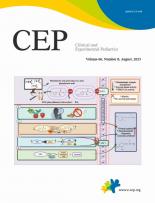In the coronavirus disease 2019 (COVID-19), most studies have demonstrated that children exhibit mild symptoms of sudden acute respiratory syndrome coronavirus 2 (SARS-CoV-2) infection [1]. However, an European report on a child with severe Kawasaki-like disease and COVID-19 led to the introduction of the term “multisystem inflammatory syndrome in children” (MIS-C) [2].
According to the World Health Organization, MIS-C is defined as: (1) fever, laboratory evidence of inflammation, and evidence of clinically severe illness requiring hospitalization with multisystem organ involvement in children and adolescents aged 0–19 years; (2) absence of alternative diagnoses; and (3) temporal association with COVID-19 demonstrated by a positive current or recent SARS-CoV-2 reverse transcription-polymerase chain reaction, serology, or antigen test result, or known COVID-19 exposure within 4 weeks prior to symptom onset [3].
COVID-9 associated MIS-C presents with cardiac involvement such as shock, elevated troponin or, pro-brain natriuretic peptide level, coronary artery involvement, ventricular dysfunction, and arrhythmia. A recent review of cardiac manifestations in patients with MIS-C reported myocarditis in 44%, coronary artery dilation or aneurysms in 6%–24%, and arrhythmias in 7%–60% [4].
Compared with adult patients, children with COVID-19 tend to have less life-threatening arrhythmias, such as premature atrial or ventricular beats, and less conduction disturbances such as first-degree atrioventricular (AV) blocks [5]. The most frequent electrocardiographic findings are low QRS amplitude, nonspecific ST segment changes and T-wave abnormalities. PR interval prolongation and first-degree AV block are also common in patients with MIS-C [6]. The incidence of life-threatening arrhythmia associated with COVID-19 in children is much lower, and has been observed in only a few case reports or case series.
Patients with SARS-CoV-2 infection may be at risk of tachyarrhythmia and bradyarrhythmia.
In this issue of Clinical and Experimental Pediatrics, Song and Kwon [7] summarized the literature on COVID-19 pediatric patients with life-threatening tachyarrhythmia and bradyarrhythmia. Nonsustained or sustained ventricular tachycardia, atrial tachycardia, and atrial fibrillation developed in cases of serious myocarditis or MIS-C with COVID-19. These arrhythmias can deteriorate a patient’s clinical condition and increase risk of mortality. Regarding bradyarrhythmia, a complete AV block is most common in patients with MIS-C; however, its incidence is as low as 2%–5 %, and most cases recovered to normal sinus rhythm. Some patients require permanent pacemaker implantation.
Myocardial injury or ischemia is a possible mechanism of arrhythmia. The pathophysiology of myocardial injury is directly related to SARS-CoV-2 infection via type 2 angiotensinconverting enzyme (ACE) receptors on the myocardial cell surface [8].
Children may be less susceptible than adults to COVID-19 because of reduced ACE type 2 receptor function in the latter. ACE inhibitors or angiotensin II receptor blockers are rarely taken by children; moreover, their effectiveness in children is lower than in adults. Hypoxia may be a secondary mechanism of arrhythmia. It induces oxygen free radical production and destroys myocardial cell membranes, causing myocardial cell injury. Inflammation plays an important role in myocardial injury, and intracellular cytokine levels are higher in patients with COVID-19 and arrhythmia.
Electrolyte disturbances, QT-prolonging drugs, and underlying cardiac conditions such as heart failure or congenital heart disease are associated with arrhythmias in COVID-19 patients [8].
A recent study demonstrated that corrected QT interval and QT dispersion were significantly more common in children with COVID-19 than in controls. Ventricular repolarization is impaired even in asymptomatic children with SARS-CoV-2 infection [9].
Although the prevalence of life-threatening arrhythmias is low among children with COVID-19, monitoring clinical status, assessing arrhythmic risk, and appropriately managing cardiac arrhythmias are crucial in MIS-C.





 PDF Links
PDF Links PubReader
PubReader ePub Link
ePub Link PubMed
PubMed Download Citation
Download Citation


